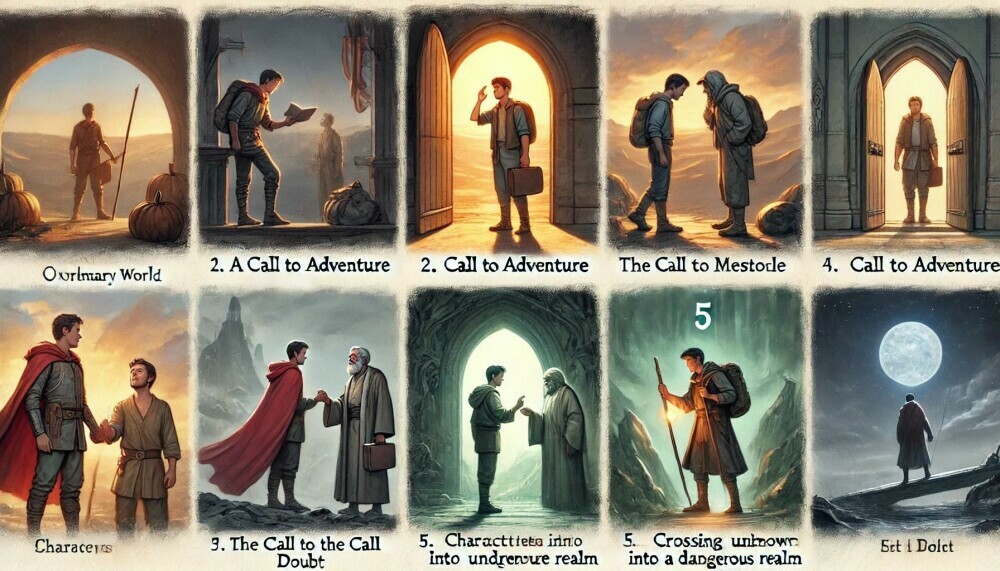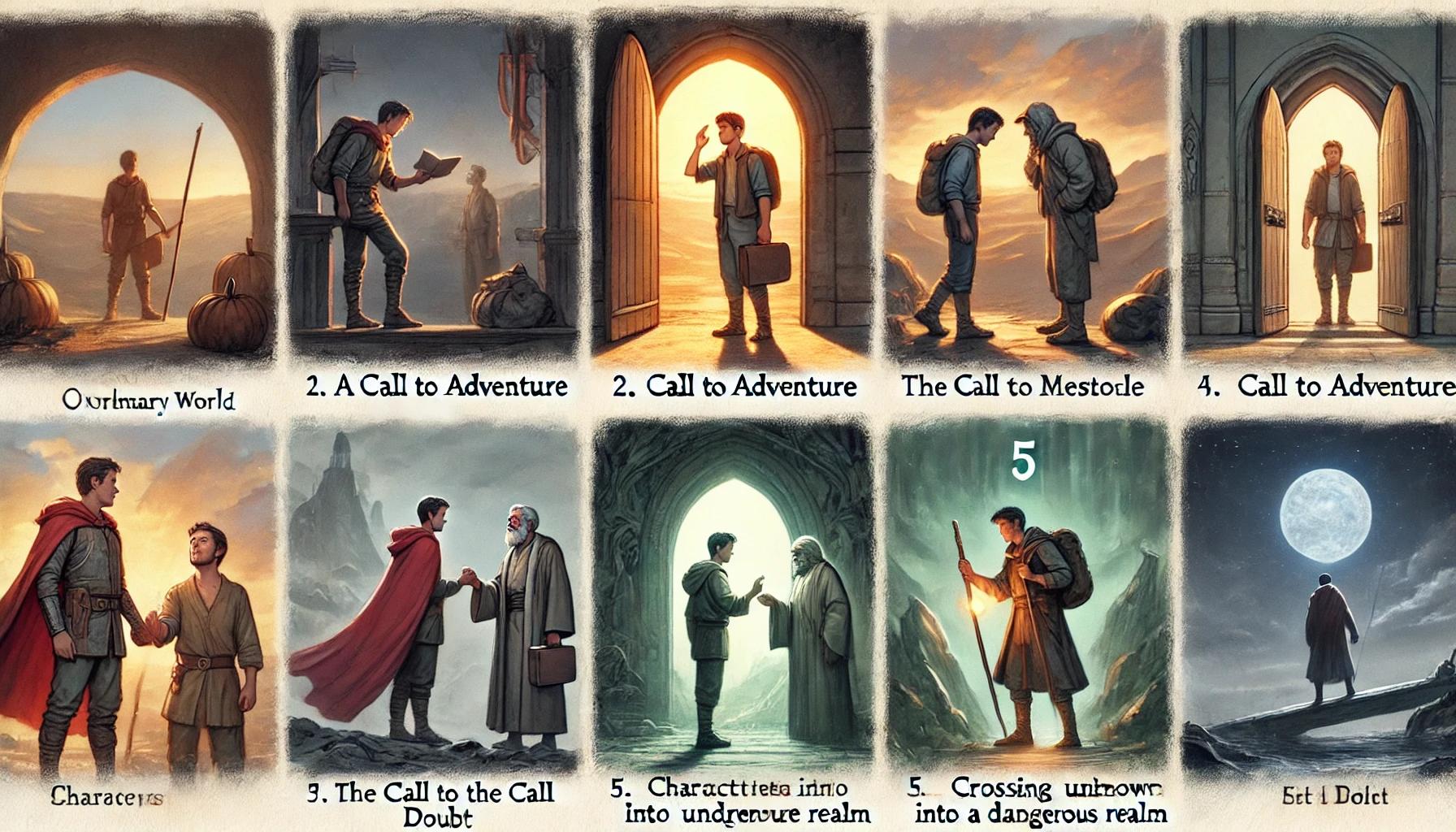
Today we are going to look at the blueprint of a character’s journey—specifically a hero’s journey, but this blueprint can work with any character. It’s a narrative framework that maps out a protagonist’s adventure from the mundane to the remarkable, a concept made famous by Joseph Campbell in his work ‘The Hero with a Thousand Faces.’
Every character begins in the ordinary world, their familiar backdrop where daily life unfolds. It doesn’t matter if their ordinary world is on earth, under the earth or in outer space, it is the world we create where their day to day life happens. It’s the comfort zone, but as with most compelling stories, it doesn’t remain comfortable for long. I’m here to help you with understanding the Call to Adventure, an event that yanks the hero from routine into the arena of challenge and risk. From Luke Skywalker’s discovery of Princess Leia’s message in ‘Star Wars’ to Katniss Everdeen volunteering as tribute in ‘The Hunger Games,’ the call is often unmistakable.
This isn’t just about accepting the call; it’s also about resisting it. Enter the Refusal of the Call. We’ve seen it in action: heroes doubting their capacity to face the challenge, providing a relatable human angle to the narrative. Think about Bilbo Baggins in ‘The Hobbit’ initially turning down the chance for adventure, illustrating his hesitancy and fear of the unknown. A story without such resistance would feel a tad less human, wouldn’t it?
Think about your own life. There have undoubtedly been instances when you have had to either accept a call to do something or struggle with refusing the call. I have refused the call far more times than I have accepted it. The struggle with refusing the call is real!
And who comes along to help alleviate those fears? The Mentor. Think Mr. Miyagi in ‘The Karate Kid’ or Dumbledore in the ‘Harry Potter’ series. These characters offer more than just advice; they are the source of wisdom, practical knowledge, and sometimes, magical support. They are essential not only for the hero’s survival but also for driving them forward when the going gets tough.
As we wrap up this section, remember that the character of the hero’s journey speaks to a universal quest for growth and meaning. It’s a story we all recognize because, in a way, we’re all living it. So, I really hope that you’ll stick around as we transition to the next part, where we’ll delve into the psychological thresholds our heroes cross as they venture into the great unknown.
The Transformational Arc: Entering the Unknown

Understanding the psychological implications of ‘Crossing the Threshold’ is crucial. It’s a moment charged with apprehension and excitement, as the hero commits to leaving the familiar behind. This is when the story’s stakes are raised; by stepping into the unknown, the hero accepts the inherent risks and possibilities of the adventure. Think of it as the start of any true transformation – a decision point that irrevocably changes the course of the narrative and the character’s life.
Let’s get into the nuts and bolts of ‘The Ordeal,’ the narrative’s climactic event. As much as it stands for external conflict, it’s also an internal clash of competing desires, fears, and values within the hero. It’s the fiery crucible in which they are reshaped. Their most profound fears are not just confronted but wrestled with, often requiring a sacrifice or a monumental change of heart to overcome. This pivotal point isn’t just for the sake of excitement; it’s a profound metaphor for personal trials that readers can resonate with.
Now, how do our characters cope with their biggest challenges? They draw on newfound strength, usually insights or skills they’ve garnered along the way. Sometimes, it’s the timely intervention of allies or the application of wisdom from the mentor. This stage is about survival, but not just in the literal sense – it’s about retaining one’s essence, beliefs, and virtues against overwhelming odds.

At the climax of the transformation, the hero ‘Seizes the Sword,’ claiming their well-earned Reward. This isn’t merely about obtaining an object or achieving a goal. It symbolizes the hero’s new understanding, capabilities, and self-perception. The Reward is more than a trophy; it represents everything the hero has learned and how they’ve changed. This moment is the first glimpse of triumph, setting the stage for the hero to begin contemplating the return journey.
Triumphant Return: Sharing the Elixir of Experience
You’ve just witnessed the protagonist’s harrowing trials, the pinnacle being the ordeal. Now, as we turn the page to the next chapter in our hero’s saga, we approach a phase that’s just as critical as the battles fought: the Return with the Elixir. This isn’t just about a literal journey back home. It’s also about how the hero integrates the lessons learned into their life and community.
Think about the transformation from where we started. Our hero ventured out from the ordinary world, confronted their deepest fears, and emerged forever changed. This metamorphosis doesn’t end with merely surviving the ordeal but continues as they bring back something invaluable from their journey—a treasure, knowledge, or even a newfound sense of self.
Often, it is a combination of those things. The most profound to me are the one’s who return with the newfound sense of self.
The Reward, often referred to as Seizing the Sword, is more than a token; it’s a symbol of the hero’s growth and what they potentially offer others. But returning home with this boon can invite both celebration and conflict. Imagine the myriad reactions from those who stayed behind, the potential jealousy, disbelief, or change in social dynamics. This is storytelling gold!
As the hero retraces their steps back to the Ordinary World, they must reconcile their new identity with their old environment. This is often where the story truly resonates with us. We see a character who now possesses the power to make a difference, to heal wounds, or to impart wisdom, reflecting on what it means to be a part of two worlds yet not fully belong to either.
In the grand tapestry of storytelling, this return isn’t solely for the hero’s benefit—it reflects the broader impact their journey has on the world they’ve come back to. It’s about the cycle of giving and receiving, of the continuous flow of communal and personal growth. Ultimately, they must answer the question: What will they do with the Elixir they’ve fought so hard to obtain?
The Hero’s Journey as a Narrative Compass

This isn’t simply a framework for epic fantasy tales or action-packed adventure films. It’s applicable across a myriad of genres, mediums, and yes, even non-fiction works. The fundamental principles of a protagonist facing challenges, undergoing transformation, and emerging victorious are ubiquitous in storytelling. It will also work with many other characters in lesser forms. In an epic novel like Stephen King’s ‘The Stand,’ several characters went through these transformations—good and bad!
In my opinion, the true elegance of the blueprint of the character’s journey lies in its adaptability. It’s like a narrative chameleon, changing hues to match the storytelling canvas, whether it’s a screenplay, novel, or even a marketing campaign. Each element from this blueprint can be tailored to fit the evolving landscape of digital content, where the journey might not be of a single character, but of an idea or a brand finding its way to public consciousness.
Consider how it speaks to personal growth and transformation. It touches us because this journey mirrors our own—the challenges we face, the mentors who guide us, and the personal victories we achieve. Its stages can serve as metaphors for life’s transitions, making this ancient narrative form as relevant today as it has ever been.
To wrap up, character’s journey isn’t confined to the pages of a book or the scenes of a movie. It’s a blueprint for life itself, offering guidance and insight into our personal narratives. Don’t be afraid to use its structure as a template for crafting your tales or understanding your experiences. The beauty of this framework is its incredible flexibility; it gives you the freedom to map your adventures—real or imagined—on a path that has stood the test of time.

